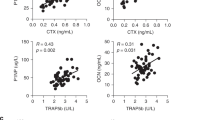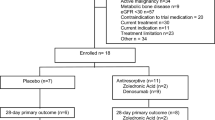Abstract
Hyponatremia is the most common electrolyte disorder and is mainly known for its neurological complications. New studies suggest previously unrecognized complications of hyponatremia, including falls, osteoporosis and fractures. Because these novel associations are mainly derived from epidemiological studies, it remains unclear whether hyponatremia has a direct effect on bone or whether it is a surrogate marker of another etiology. However, one animal and one in vitro study now show that hyponatremia can have direct effects on bone, mainly via activation of osteoclasts. The association between hyponatremia and fractures appears to be independent of osteoporosis (defined as low BMD). Also, data suggest that this association cannot be fully explained by the possibility that hyponatremia predisposes to falls. Hyponatremia, therefore, also has an effect on bone quality that is not captured by BMD. Here, the emerging relationship between hyponatremia and bone is reviewed, with special emphasis on possible mechanisms, unanswered questions and clinical implications.
Key Points
-
Recent studies suggest that hyponatremia, the most common electrolyte disorder, affects not only the brain but also bone
-
Several epidemiological studies have identified associations between hyponatremia and increased risk of falls and fractures and, in one study, with decreased BMD
-
The associations between mild hyponatremia and increased fracture risk cannot be fully explained by increased risk of falling and appear to be independent of BMD
-
One animal study and one cell culture study found that a low sodium concentration in serum or medium increased osteoclast activity
-
Hyponatremia could be a new clinical risk factor for osteoporosis and fractures
-
Future studies are needed to show whether the relationship between hyponatremia and fractures is causal and whether correction of hyponatremia reduces fracture risk
This is a preview of subscription content, access via your institution
Access options
Subscribe to this journal
Receive 12 print issues and online access
$209.00 per year
only $17.42 per issue
Buy this article
- Purchase on Springer Link
- Instant access to full article PDF
Prices may be subject to local taxes which are calculated during checkout


Similar content being viewed by others
References
Adrogué, H. J. & Madias, N. E. Hyponatremia. N. Engl. J. Med. 342, 1581–1589 (2000).
Hoorn, E. J. & Zietse, R. Hyponatremia revisited: translating physiology to practice. Nephron. Physiol. 108, p46–p59 (2008).
Hoorn, E. J., Lindemans, J. & Zietse, R. Development of severe hyponatraemia in hospitalized patients: treatment-related risk factors and inadequate management. Nephrol. Dial. Transplant. 21, 70–76 (2006).
Upadhyay, A., Jaber, B. L. & Madias, N. E. Incidence and prevalence of hyponatremia. Am. J. Med. 119, S30–S35 (2006).
Arieff, A. I. Hyponatremia, convulsions, respiratory arrest, and permanent brain damage after elective surgery in healthy women. N. Engl. J. Med. 314, 1529–1535 (1986).
Sterns, R. H., Riggs, J. E. & Schochet, S. S. Jr. Osmotic demyelination syndrome following correction of hyponatremia. N. Engl. J. Med. 314, 1535–1542 (1986).
Ayus, J. C., Achinger, S. G. & Arieff, A. Brain cell volume regulation in hyponatremia: role of sex, age, vasopressin, and hypoxia. Am. J. Physiol. Renal Physiol. 295, F619–F624 (2008).
Ayus, J. C., Wheeler, J. M. & Arieff, A. I. Postoperative hyponatremic encephalopathy in menstruant women. Ann. Intern. Med. 117, 891–897 (1992).
Ayus, J. C., Krothapalli, R. K. & Arieff, A. I. Treatment of symptomatic hyponatremia and its relation to brain damage. A prospective study. N. Engl. J. Med. 317, 1190–1195 (1987).
Lohr, J. W. Osmotic demyelination syndrome following correction of hyponatremia: association with hypokalemia. Am. J. Med. 96, 408–413 (1994).
Renneboog, B., Musch, W., Vandemergel, X., Manto, M. U. & Decaux, G. Mild chronic hyponatremia is associated with falls, unsteadiness, and attention deficits. Am. J. Med. 119, 71.e1–e8 (2006).
Arányi, Z., Kovács, T., Szirmai, I. & Vastagh, I. Reversible nerve conduction slowing in hyponatremia. J. Neurol. 251, 1532–1533 (2004).
Gankam Kengne, F., Andres, C., Sattar, L., Melot, C. & Decaux, G. Mild hyponatremia and risk of fracture in the ambulatory elderly. QJM 101, 583–588 (2008).
Hoorn, E. J. et al. Mild hyponatremia as a risk factor for fractures: The Rotterdam Study. J. Bone Miner. Res. 26, 1822–1828 (2011).
Kinsella, S., Moran, S., Sullivan, M. O., Molloy, M. G. & Eustace, J. A. Hyponatremia independent of osteoporosis is associated with fracture occurrence. Clin. J. Am. Soc. Nephrol. 5, 275–280 (2010).
Sandhu, H. S., Gilles, E., DeVita, M. V., Panagopoulos, G. & Michelis, M. F. Hyponatremia associated with large-bone fracture in elderly patients. Int. Urol. Nephrol. 41, 733–737 (2009).
Ayus, J. C. & Arieff, A. I. Chronic hyponatremic encephalopathy in postmenopausal women: association of therapies with morbidity and mortality. JAMA 281, 2299–2304 (1999).
Ayus, J. C. & Moritz, M. L. Bone disease as a new complication of hyponatremia: moving beyond brain injury. Clin. J. Am. Soc. Nephrol. 5, 167–168 (2010).
Rachner, T. D., Khosla, S. & Hofbauer, L. C. Osteoporosis: now and the future. Lancet 377, 1276–1287 (2011).
Verbalis, J. G. et al. Hyponatremia-induced osteoporosis. J. Bone Miner. Res. 25, 554–563 (2010).
Fabian, T. J. et al. Paroxetine-induced hyponatremia in older adults: a 12-week prospective study. Arch. Intern. Med. 164, 327–332 (2004).
Kerse, N. et al. Falls, depression and antidepressants in later life: a large primary care appraisal. PLoS ONE 3, e2423 (2008).
Ziere, G. et al. Selective serotonin reuptake inhibiting antidepressants are associated with an increased risk of nonvertebral fractures. J. Clin. Psychopharmacol. 28, 411–417 (2008).
Ziere, G., Dieleman, J. P., van der Cammen, T. J. & Stricker, B. H. Association between SSRI use and fractures and the effect of confounding by indication. Arch. Intern. Med. 167, 2369–2370; author reply 2370–2371 (2007).
Kinsella, S., Chavrimootoo, S., Molloy, M. G. & Eustace, J. A. Moderate chronic kidney disease in women is associated with fracture occurrence independently of osteoporosis. Nephron Clin. Pract. 116, c256–c262 (2010).
Beukhof, C. M., Hoorn, E. J., Lindemans, J. & Zietse, R. Novel risk factors for hospital-acquired hyponatraemia: a matched case–control study. Clin. Endocrinol. (Oxf.) 66, 367–372 (2007).
Borgens, R. B. Endogenous ionic currents traverse intact and damaged bone. Science 225, 478–482 (1984).
Ecelbarger, C. A. et al. Role of renal aquaporins in escape from vasopressin-induced antidiuresis in rat. J. Clin. Invest. 99, 1852–1863 (1997).
Machnik, A. et al. Macrophages regulate salt-dependent volume and blood pressure by a vascular endothelial growth factor-C-dependent buffering mechanism. Nat. Med. 15, 545–552 (2009).
Barsony, J., Sugimura, Y. & Verbalis, J. G. Osteoclast response to low extracellular sodium and the mechanism of hyponatremia-induced bone loss. J. Biol. Chem. 286, 10864–10875 (2011).
Basu, S., Michaëlsson, K., Olofsson, H., Johansson, S. & Melhus, H. Association between oxidative stress and bone mineral density. Biochem. Biophys. Res. Commun. 288, 275–279 (2001).
Yamaguchi, T. The calcium-sensing receptor in bone. J. Bone Miner. Metab. 26, 301–311 (2008).
Hoorn, E. J. et al. Osmomediated natriuresis in humans: the role of vasopressin and tubular calcium sensing. Nephrol. Dial. Transplant. 24, 3326–3333 (2009).
Tseng, A. S., Beane, W. S., Lemire, J. M., Masi, A. & Levin, M. Induction of vertebrate regeneration by a transient sodium current. J. Neurosci. 30, 13192–13200 (2010).
Reid, B., Song, B., McCaig, C. D. & Zhao, M. Wound healing in rat cornea: the role of electric currents. Faseb J. 19, 379–386 (2005).
Zhao, M. et al. Electrical signals control wound healing through phosphatidylinositol-3-OH kinase-γ and PTEN. Nature 442, 457–460 (2006).
Komarova, S. V., Dixon, S. J. & Sims, S. M. Osteoclast ion channels: potential targets for antiresorptive drugs. Curr. Pharm. Des. 7, 637–654 (2001).
Chen, L., Liu, C., Liu, L. & Cao, X. Changes in osmolality modulate voltage-gated sodium channels in trigeminal ganglion neurons. Neurosci. Res. 64, 199–207 (2009).
Hoorn, E. J. & Zietse, R. Hyponatremia and mortality: how innocent is the bystander? Clin. J. Am. Soc. Nephrol. 6, 951–953 (2011).
Wald, R., Jaber, B. L., Price, L. L., Upadhyay, A. & Madias, N. E. Impact of hospital-associated hyponatremia on selected outcomes. Arch. Intern. Med. 170, 294–302 (2010).
Chawla, A., Sterns, R. H., Nigwekar, S. U. & Cappuccio, J. D. Mortality and serum sodium: do patients die from or with hyponatremia? Clin. J. Am. Soc. Nephrol. 6, 960–965 (2011).
Hoorn, E. J., Hotho, D., Hassing, R. J. & Zietse, R. Unexplained hyponatremia: seek and you will find. Nephron. Physiol. 118, p66–p71 (2011).
Author information
Authors and Affiliations
Contributions
E. J. Hoorn researched the data for the article. E. J. Hoorn, R. Zietse and M. C. Zillikens provided a substantial contribution to discussions of the content. E. J. Hoorn, G. Liamis and M. C. Zillikens contributed equally to writing the article. All authors reviewed and/or edited the manuscript before submission.
Corresponding author
Ethics declarations
Competing interests
The authors declare no competing financial interests.
Rights and permissions
About this article
Cite this article
Hoorn, E., Liamis, G., Zietse, R. et al. Hyponatremia and bone: an emerging relationship. Nat Rev Endocrinol 8, 33–39 (2012). https://doi.org/10.1038/nrendo.2011.173
Published:
Issue Date:
DOI: https://doi.org/10.1038/nrendo.2011.173
This article is cited by
-
Hyponatremia, Hypokalemia, and Fragility Fractures in Old Patients: More than an Association?
Calcified Tissue International (2020)
-
Association between diuretic use and the risk of vertebral fracture after stroke: a population-based retrospective cohort study
BMC Musculoskeletal Disorders (2019)
-
Hyponatremia and hypernatremia are associated with increased 30-day mortality in hip fracture patients
Osteoporosis International (2016)
-
Neuronal distress induced by low extracellular sodium in vitro is partially reverted by the return to normal sodium
Journal of Endocrinological Investigation (2016)
-
Vasopressin Receptor Antagonists
Current Hypertension Reports (2015)



